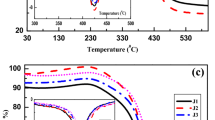Abstract
Perhydrous bituminous coal has multi-purpose industrial applications established by its distinctive thermal behavior. The Huainan coalfield in China has a large volume of these types of coals. Nevertheless, little information is obtainable with respect to their thermodynamic characteristics. In this study, one representative coal sample, selected from Zhuji Coal Mine, was scrutinized using thermogravimetry/mass spectrometry at different heating rates. The observed results indicate that the process of thermal decomposition of this sample can be partitioned into three evident stages associated with its mass loss rates and the releasing of gaseous species. The secondary pyrolysis step (300–600 °C), in particular, was affected by means of the alterations of heating rate. The maximum mass loss rate and the releasing rate of gaseous species increased related with the increase of heating rate. To achieve reliable kinetic parameters, the Coats–Redfern and Flynn–Wall–Ozawa methods are integrated. The activation energy is applicable in the range of 108–224 kJ mol−1.






Similar content being viewed by others
References
Safarova M, Kusy J, Andel L. Pyrolysis of brown coal under different process conditions. Fuel. 2005;84:2280–5.
Niksa S. Flash chain theory for rapid coal devolatilization kinetics. Part 7. Predicting the release of oxygen species from various coals. Energy Fuels. 1996;10:173–87.
Costa A, Flores D, Suarez-Ruiz I, Pevida C, Rubiera F, Iglesias MJ. The importance of thermal behavior and petrographic composition for understanding the characteristics of a Portuguese perhydrous Jurassic coal. Int J Coal Geol. 2010;84:237–47.
Iglesias MJ, Jiménez A, Laggoun-Dféarge F, Suráez-Ruiz I. FTIR study of pure vitrains and associated coals. Energy Fuels. 1995;5:458–66.
Iglesias MJ, del Rio JC, Laggoun-Dféarge F, Cuesta MJ, Suráez-Ruiz I. Control of the chemical structure of perhydrous coals; FTIR and Py–GC/MS investigation. J Anal Appl Pyrol. 2002;62:1–5.
Solomon PR, Carangelo RM. FTIR analysis of coal: II. Aliphatic and aromatic hydrogen concentration. Fuel. 1988;67:949–59.
Jiménez A, Iglesias MJ, Laggoun-Dféarge F, Suráez-Ruiz I. Effect of the increase in temperature on the evolution of the physical and chemical structure of vitrinite. J Anal Appl Pyrol. 1999;50:117–48.
Wu D, Liu GJ, Sun RY. Investigation on structural and thermodynamic characteristics perhydrous bituminous coal by Fourier transform infrared spectroscopy and thermogravimetry/mass spectrometry. Energy Fuels. 2014;28:3024–35.
Moukhina E. Determination of kinetic mechanisms for reaction measured with thermoanalytical instruments. J Therm Anal Calorim. 2012;109:1203–14.
Deng J, Wang K, Zhang YN, Yang H. Study on the kinetics and reactivity at the ignition temperature of Jurassic coal in North Shaanxi. J Therm Anal Calorim. 2014;118:417–8.
Anthony DB, Howard JB, Hottel HC, Meissner HP. Fifteenth symposium (international) on combustion. Pittsburgh: The Combustion Institute; 1975. p. 1303–17.
Gavalas GR, Wilks KA. Intraparticle mass transfer in coal pyrolysis. AIChE J. 1980;26:201–10.
Solomon PR. United Technologies Research Center Report. 1977; R77-952588-3.
Ahmad T, Awan IA, Nisar J, Ahmad I. Influence of inherent minerals and pyrolysis temperature on the yield of pyrolysates of some Pakistani coals. Energy Convers Manage. 2009;50:1163–71.
Zhao YC, Zhang JY, Zheng CG. Transformation of aluminum-rich minerals during combustion of a bauxite-bearing Chinese coal. Int J Coal Geol. 2012;94:182–8.
Solomon PR. United Technologies Research Center Report. 1977; R77-952588-2.
Solomon PR, Fletcher TH, Pugmire RJ. Progress in coal pyrolysis. Fuel. 1993;72:587–8.
KoK MV. Thermal characterization of different origin class-G cements. J Therm Anal Calorim. 2014;115:1533–9.
GB/T 212-2008, Standards Press of China, Beijing, 2008. pp. 1–14 (in Chinese).
GB/T 476-2008, Standards Press of China, Beijing, 2008. pp. 1–16, (in Chinese).
GB/T 214-2007, Standards Press of China, Beijing, 2007. pp. 1–10 (in Chinese).
GB/T 215-2003, Standards Press of China, Beijing, 2003. pp. 1–8 (in Chinese).
GB/T 5751-86, Standards Press of China, Beijing, 1986. pp. 1–10 (in Chinese).
ASTM D388, Annual book of ASTM standards. Gaseous fuels: coal and coke, vol. 05. 06. Test method for ash in the analysis sample of coal and coke, 1991.
Arenillas A, Rubiera F, Pevida C, Pis JJ. A comparison of different methods for predicting coal devolatilization kinetics. J Anal Appl Pyrol. 2001;58:685–6.
Arenillas A, Rubiera F, Pis JJ, Cuesta MJ, Iglesias MJ, Jiménez A, Suráez-Ruiz I. Thermal behaviour during the pyrolysis of low-rank perhydrous coals. J Anal Appl Pyrol. 2003;68:371–85.
Arenillas A, Pevida C, Rubiera F, García R, Pis JJ. Characterisation of model compounds and a synthetic coal by TG/MS/FTIR to represent the pyrolysis behaviour of coal. J Anal Appl Pyrol. 2004;71:747–63.
Wang SQ, Tang YG, Schobert HH, Mitchell GD, Liao FR, Liu ZZ. A thermal behavior study of Chinese coals with high hydrogen content. Int J Coal Geol. 2010;81:37–44.
Van Krevelen DW. Graphical-statistical method for the study of structure and reaction process of coal. Fuel. 1950;29:269–84.
Hodek W, Kirschstein J, Van Heek KH. Reactions of oxygen containing structures in coal pyrolysis. Fuel. 1991;70:424–8.
Coats AW, Redfern JP. Kinetic parameters from thermogravimetric data. Nature. 1964;68:201–2.
Lei M, Wang CB, Wang SL. Effect of pyrolysis characteristics on ignition mechanism and NO emission of pulverized coal during oxy-fuel combustion. J Therm Anal Calorim. 2014;117:665–8.
Polli H, Pontes LAM, Araujo AS. Application of model-free kinetics to the study of thermal degradation of polycarbonate. J Therm Anal Calorim. 2005;79:383–7.
Lin YK, Li QS, Li XF, Ji K, Zhang HP, Yu YM, Song YH, Fu Y, Sun LY. Pyrolysates distribution and kinetics of Shenmu long flame coal. Energy Convers Manage. 2014;86:428–34.
Doyle CD. Series approximations to the equations of thermogravimetric data. Nature. 1965;207:290–91.
Sarwar A, NasiruddinKhan M, Azhar KF. Kinetic studies of pyrolysis and combustion of thar coal by thermogravimetry and chemometric data analysis. J Anal Appl Pyrol. 2012;109:97–5.
Acknowledgements
The authors acknowledge the support from the National Basic Research Program of China (973 Program, 2014CB238903) and the National Natural Science Foundation of China (Nos. 41173032 and 41373110). We thank two anonymous reviewers for their constructive comments.
Author information
Authors and Affiliations
Corresponding author
Rights and permissions
About this article
Cite this article
Wu, D., Liu, G., Chen, S. et al. An experimental investigation on heating rate effect in the thermal behavior of perhydrous bituminous coal during pyrolysis. J Therm Anal Calorim 119, 2195–2203 (2015). https://doi.org/10.1007/s10973-015-4401-y
Received:
Accepted:
Published:
Issue Date:
DOI: https://doi.org/10.1007/s10973-015-4401-y




